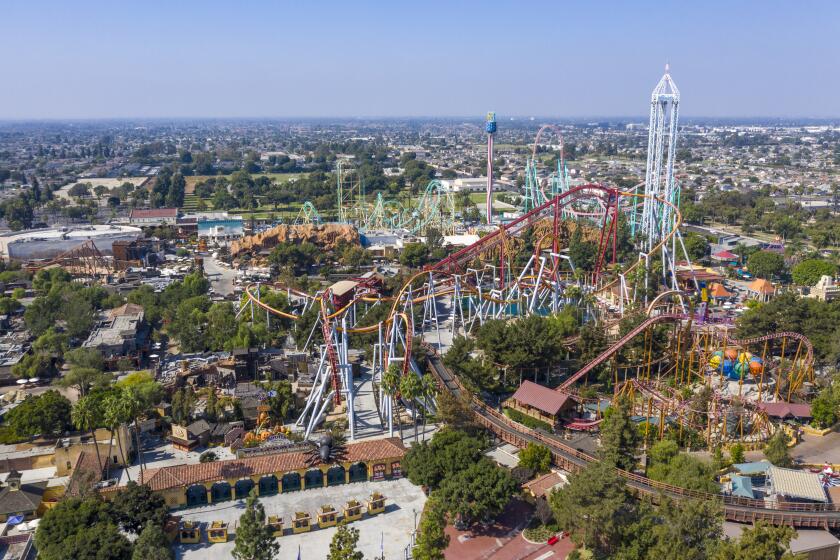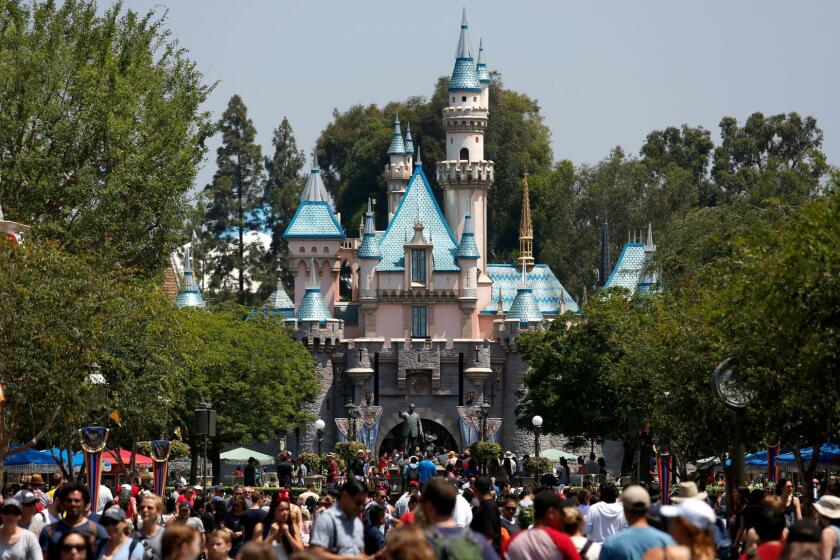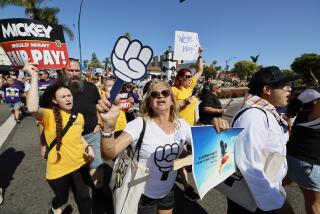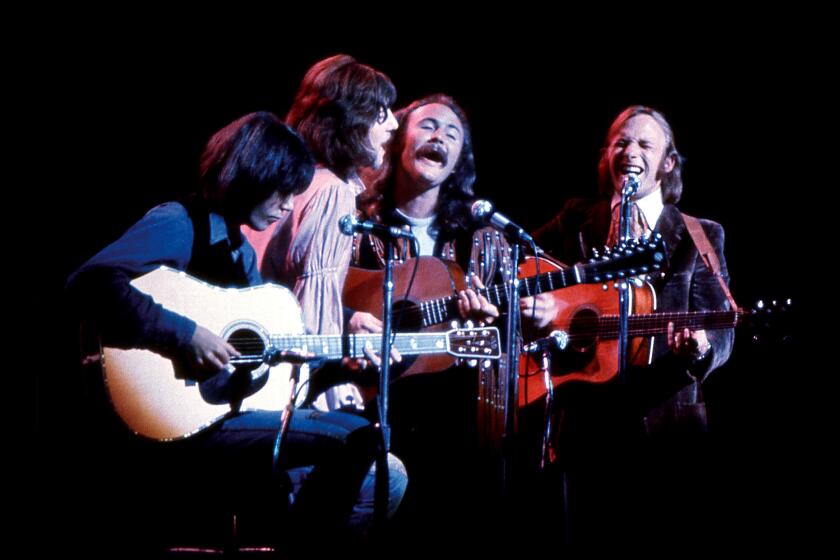Commentary: Disney’s theme park workers are the true superheroes amid layoffs and COVID-19
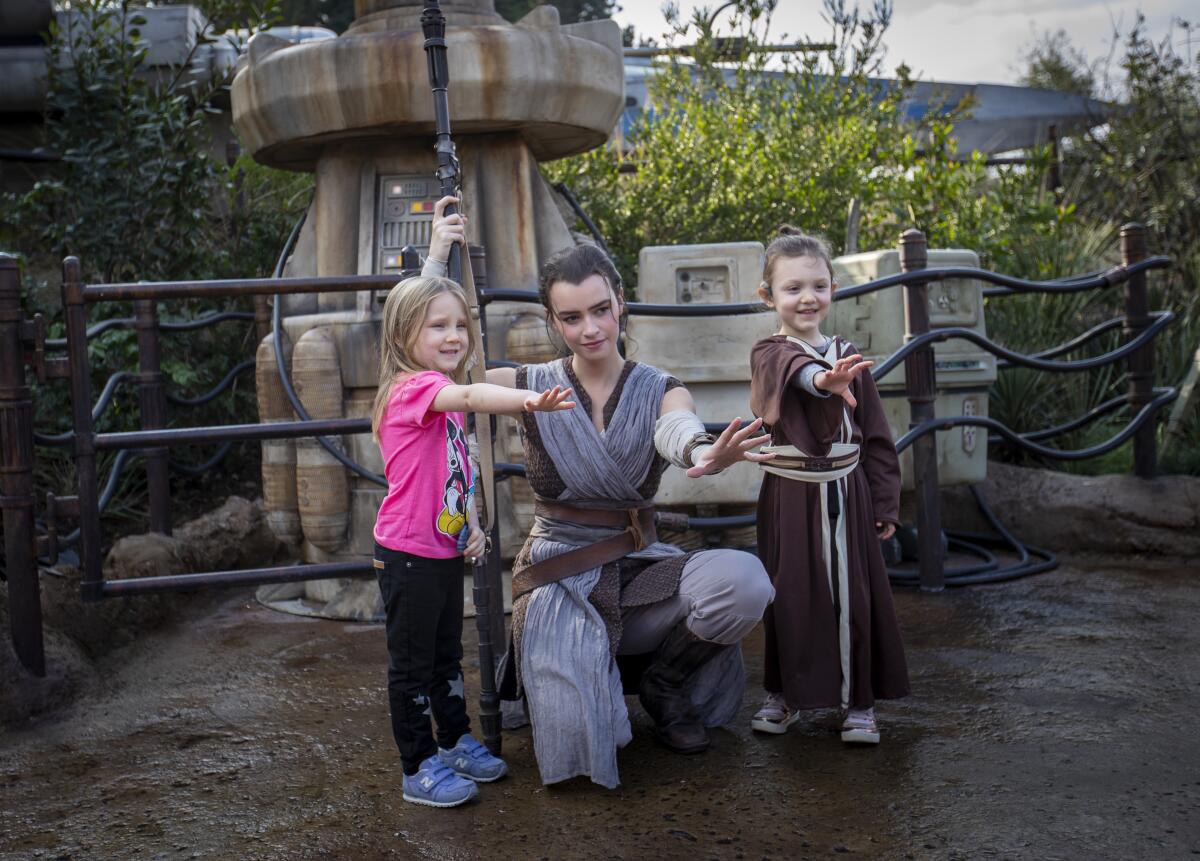
- Share via
The American diner is a great place to spend an afternoon and contemplate life while watching the cars go by. Even if those cars are on a fixed track surrounded by handmade rocks inside a Disney theme park.
“You see that?” asked a staffer at Flo’s V8 Cafe inside Disney California Adventure as I stared into my laptop on a February weekday and tried to finish a work assignment. She was pointing at a construction crane where a new Marvel-themed Avengers Campus was scheduled to open this summer — before life was derailed by the COVID-19 pandemic. “That’s the newest superhero. We don’t have a name for him yet, though.”
“The construction equipment is your new superhero?” I asked. She gave me a puzzled look and took a step back in mock offense. This was no ordinary construction crane, she insisted. Look again, she said, and I’d see how some of the tools affixed to the crane gave it the appearance of eyes, transforming that hunk of metal into an as-yet-unnamed creature.
“See? I told you it was superhero. It’s watching us.” And then she was off, back to busing tables.
When we talk about going to a place such as Disneyland — and pre-pandemic around 19 million of us did so every year — most bring up favorite rides, nostalgic family moments or some sort of high-caloric treat. But many of us go because we sometimes need to be prodded to look at life — and our own environment — a little differently. To be reminded that nothing that surrounds us is ever mundane as long as we pause to play. To understand that a construction crane can sometimes be a superhero.
What we usually don’t say is that we go to Disneyland to interact with its staff, known in the park as cast members. But just because it’s unsaid doesn’t make it untrue. The romance of Main Street, the elegance of New Orleans Square, the adventure of Galaxy’s Edge and the silliness of Cars Land, where Flo’s V8 Cafe is located, could not exist without the cast that brings those art-directed theme park universes to life.
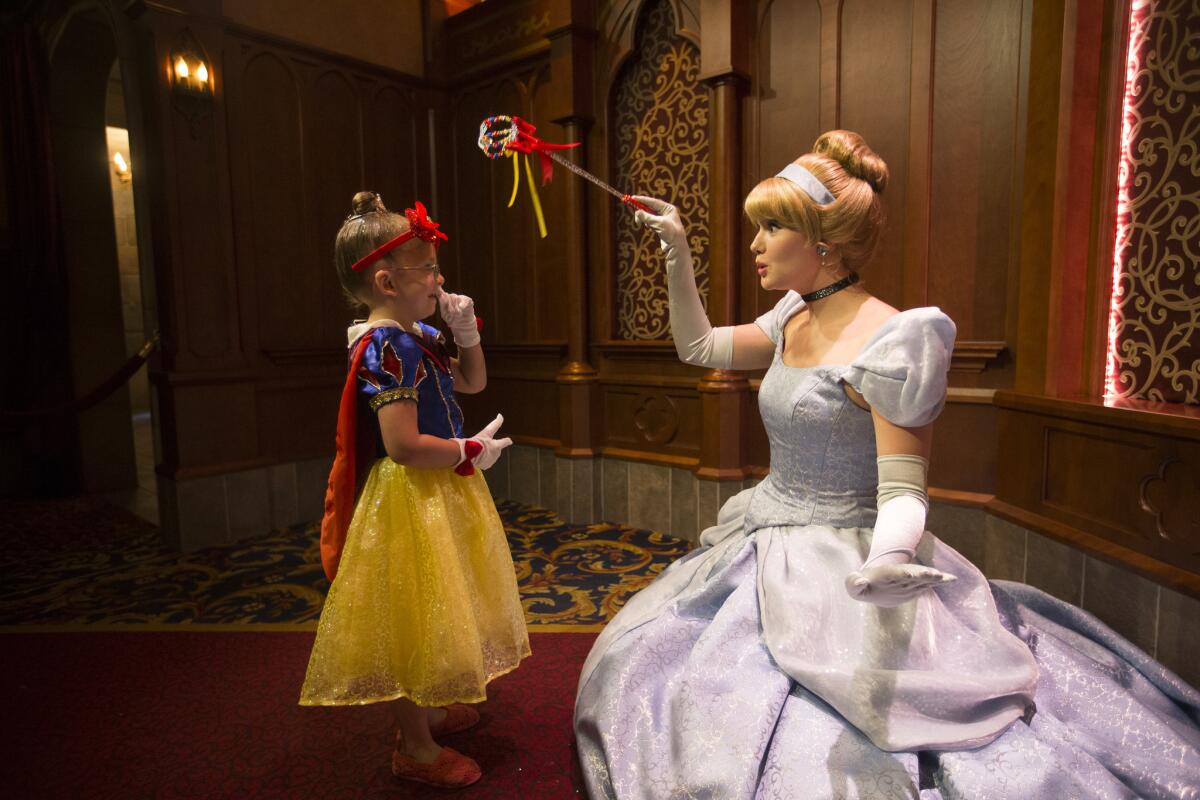
The struggles and the horrors of 2020 — the fear of contracting a deadly virus, the anxieties surrounding finances and employment, the still-unknown long-term emotional effects of our suddenly solitary lives — worsened with the recent news that Disney would lay off nearly 30,000 of its cast, a number Disney warned could increase after California released new guidelines this week that would keep Disneyland and other major theme parks closed for the foreseeable future. Included in the cuts were more than 400 of Disney’s Imagineers.
While those not personally affected can’t relate to the blow of losing what for many was likely a dream job, Disney fans have certainly felt the loss, as evidenced by the fundraisers and resources the community has continued to boost, as various fan-driven initiatives have managed to raise tens of thousands to support those affected.
Disneyland, Knott’s Berry Farm and other large California theme parks won’t open immediately under protocols announced Tuesday.
Since Disneyland’s 1955 founding, the park has ebbed, flowed and reflected the country’s pop-culture fascination, less an idealized vision of American principles and more a desire to amplify our myths and the stories we pass down through generations.
Disneyland has long been where this country turns in dark times, perhaps even born of them. In a post-WWII America that was adjusting to more internalized, less-overtly visible fears, the specter of nuclear annihilation loomed large, and the Cold War heightened the sense of uncertainty. The company’s decision to cut about 13% of its 223,000-person global workforce was partly a result of the last six months but also a statement that drives home the reality that the path out of our current state will be long and that the place that has been the very model of American leisure for the last six decades won’t be approaching normal on any known timetable.
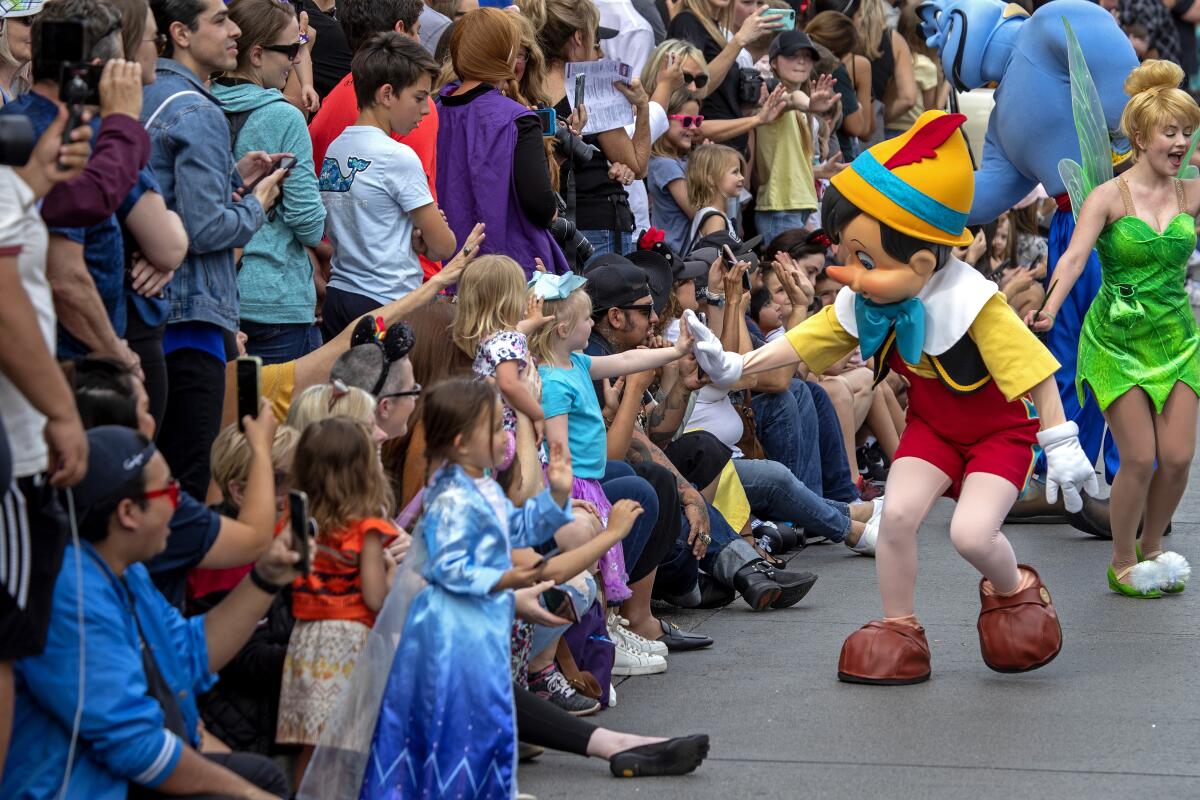
It made clear, if it wasn’t already, that America’s bungled response to the pandemic has rendered fragile an untold number of livelihoods.
“I can fix your mood,” said a Disney cast member who was furloughed in March and who was awaiting word on his job, a waiter at one of the park’s sit-down restaurants.
Declining to be identified for this story (Disney has strict rules about its staff speaking with the media, and most who were reached by this reporter were still unsure of their job status), the cast member explained the difference between working at Disney and just about everywhere else.
At other restaurants, he said, if a guest came in stressed or unhappy, chances are they would leave stressed and unhappy. But at Disneyland? Moods are far more malleable.
A princess autograph
The family in the lobby of the Grand Californian Hotel was upset. Its members had passes for Disneyland, but their little girl’s heart was set on meeting Anna and Elsa of “Frozen,” and the princesses were at Disney California Adventure, which the family did not have tickets for. And no, the family wasn’t interested in spending more money for access to an additional park.
“The mom was very disappointed,” a former Jungle Cruise skipper-turned-Grand Californian staffer said of this pre-pandemic scene. “I told them they could see them in the parade but probably couldn’t do a proper meet and greet. The little girl was sad and wanted an autograph. So I went in the back and got a signed photo of Anna and Elsa. Then I waited. And I waited a few extra seconds. And then I burst through the door and acted like I was out of breath. I ran over to them, completely out of breath, and said, ‘I ran all the way to California Adventure to get the autograph.’ And the kid was all, ‘Really? Wow!’”
There are stories of similar, even greater acts, that occur at Disney theme parks every day. And while that moment didn’t result in a child getting one-on-one time with Arendelle royalty, it’s a small example of how working at, say, a front desk at a Disney hotel requires a different skill set than working at a front desk at just about every hotel.
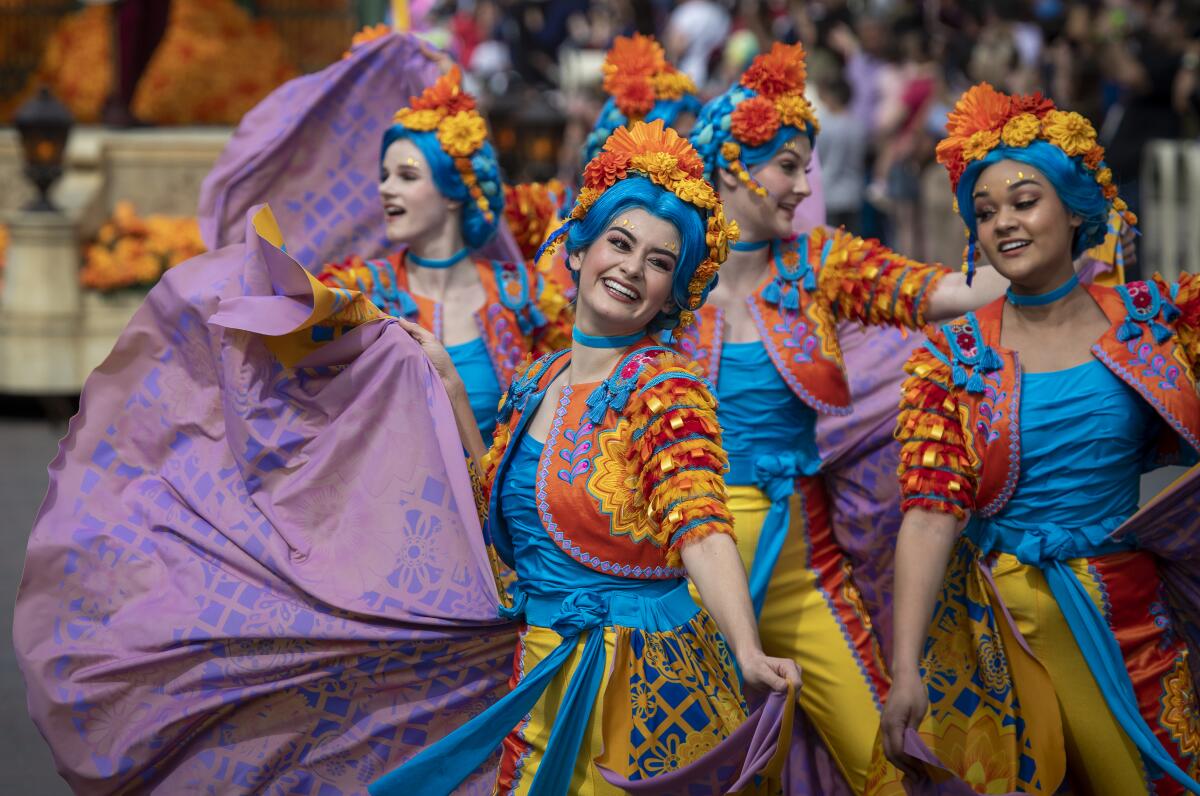
I once witnessed the Disneyland Hotel’s front desk staff mobilize when a family arrived from the airport with a child who had an earache and was in pain. In moments, Goofy was there with balloons, and another check-in clerk was behind the character with a box of chocolates, all while yet another cast member arranged transportation to an urgent-care facility.
These occurrences and others are why news reports regarding salary disputes with Disney and the unions that represent much of its front-line staff resonate so much with fans of the park. At Disney, there’s no such thing as just a retail clerk.
The pain of layoffs
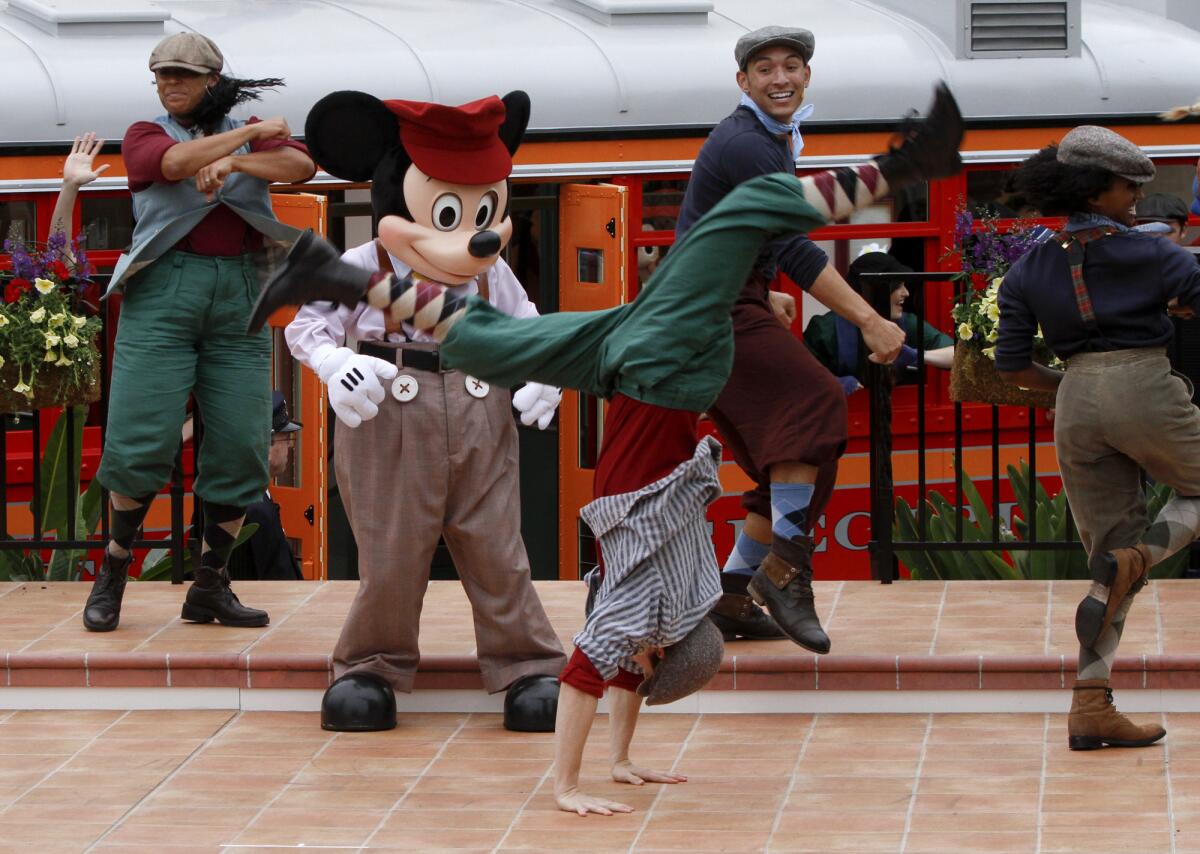
A staff reduction the magnitude of 28,000 would be national news in any era, regardless of the company. Disney, however, commands attention whenever it makes a public statement. That’s partly because of its size and cultural assets. And partly because of its public image and the mammoth wealth of its top executives. Sen. Elizabeth Warren (D-Mass.) recently criticized the company for “hanging its front-line workers out to dry” while taking “good care of its top executives and shareholders.” (Disney said she’s “misinformed.”)
Then there’s Disney’s global and historical significance. Disneyland has been copied not just in Florida but also in Tokyo, Paris, Hong Kong and Shanghai. It’s America’s most recognizable pop export.
There’s an American history course that could be taught solely by looking at Disneyland. It could be argued that It’s a Small World was born out of the financial and cultural changes happening amid the globalization of the mid-1960s. More recently, Disneyland’s “Star Wars”-inspired Galaxy’s Edge is a study in contrasts — the haves and the have-nots and the moral values of each in a modern world where the middle is eroded.
Sometimes, Disneyland is late to the cultural moment. An announcement that Splash Mountain would be re-themed to “The Princess and the Frog” was made amid this year’s Black Lives Matter movement, despite the racist text that informs the original attraction being long well known. Other times, it’s not. In 2015, responding to longtime complaints but ahead of the cultural reassessments that would occur with the Trump presidency and the #MeToo/Time’s Up movements, Disney removed a scene from Pirates of the Caribbean in which women were auctioned, avoiding what likely would have been an uncomfortable microscope just a few months later.
This is your brain on Disneyland: A Disney addict’s quest to discover why he loves the parks so much
My name is Todd and I am addicted to Disney theme parks.
And Disneyland, despite its closure, is still reflecting our culture, as fractured and divisive at it may be. In announcing the layoffs, Josh D’Amaro, Disney’s chairman of parks, experiences and products, cited the continued effects of the pandemic on operations, but also said the company’s issues had been “exacerbated in California by the state’s unwillingness to lift restrictions that would allow Disneyland to reopen.”
If Disneyland had been able to open in July as planned, it’s unknown what effect that might have had on the many thousands of cuts at Florida’s Walt Disney World or the deep trims to Imagineering. The International Assn. of Amusement Parks and Attractions trade group estimates that the industry at large has lost 235,000 jobs across the country. It’s a figure that raises the question as to whether the theme park model, one often necessitating a large attendance, is even compatible with our current physical distancing lifestyle.
It’s quite possible that Disneyland won’t fully reopen until well into 2021. California guidelines prohibit the theme park from operating until Orange County enters the state’s least-restrictive tier for novel coronavirus transmission. Disney reacted forcefully, noting in a statement attributed to Disneyland President Ken Potrock that the regulations “will keep us shuttered for the foreseeable future, forcing thousands more people out of work, leading to the inevitable closure of small family-owned businesses, and irreparably devastating the Anaheim/Southern California community.”
Disney, and Disneyland in particular, has trained me to be an optimist, so I’d have preferred that statement to have been reframed. Attacking health measures definitely isn’t a good look, so how about noting that California’s guidelines, which ultimately are designed to keep its residents alive, reinforce the need for physical distancing, mask-wearing and for powerful corporations to put pressure on Congress to pass a strong stimulus package that protects our workers and small businesses?
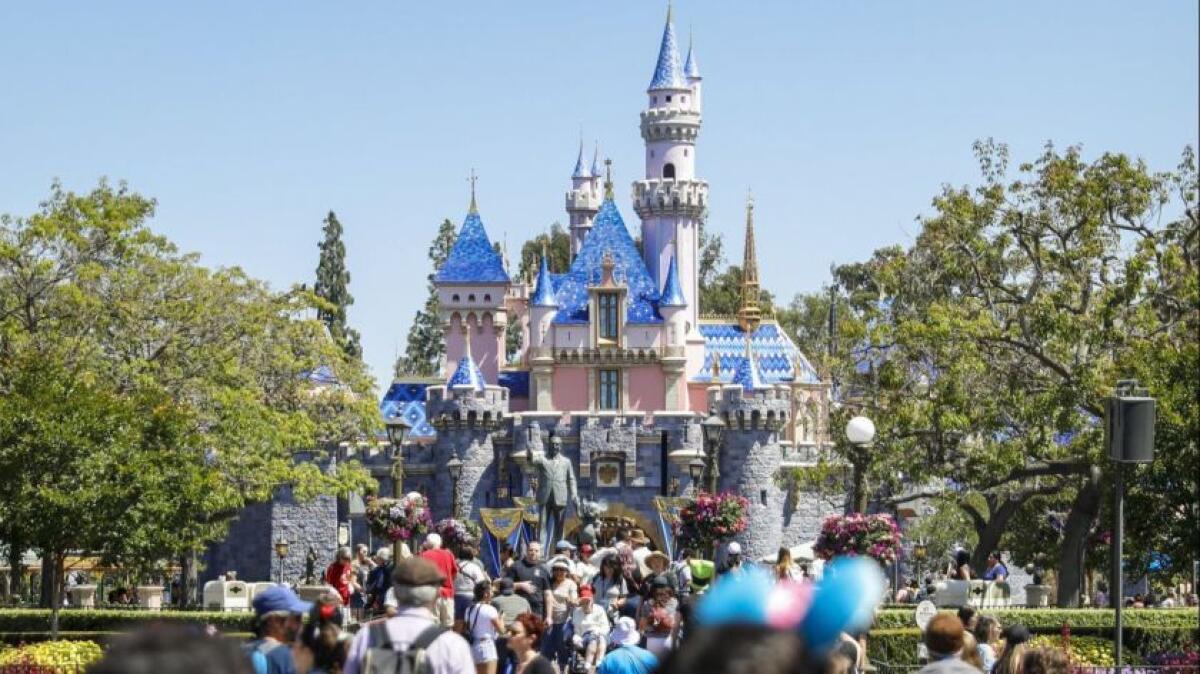
Such a statement could be followed with images of Mickey Mouse, Queen Anna and Princess Tiana in various mask-wearing PSA ads, letting us know that there is a path to reach the desired tier rather than simply implying impossibility. But as 2020 enters its final laps, bleakness abounds.
We’re barreling toward an election with a president and a Congress seemingly dangling COVID-19 relief efforts after votes are tallied. America’s response to the pandemic — at least for now — increasingly looks like it will be remembered for its battle lines, a response in which personal health and business stability have been framed as an either/or.
Disney is caught in this fray. The public, in California at least, appears to favor a cautious approach, with recent polling suggesting that the majority of residents back Gov. Gavin Newsom’s response to the pandemic. As we learned when rushing to open this summer, there is no fast-forward to normalcy.
The line between pushing for business to return while not attacking public health measures is a thin one. It can, admittedly, also be a confusing and contradictory one, especially when we’re operating without a strong national COVID-19 policy and rules vary from state to state, which will undoubtedly result in corporate and consumer frustration. And that’s where we, and Disneyland, currently reside.
One cast member told me that he would go back to work if called but that it would not be an easy decision, as doing so would mean isolating himself for the foreseeable future from his ailing mother.
“I understand Disney’s frustrations, and I also sympathize with the governor,” said another cast member, who then succinctly summed up the year and what appears to be our future. “It’s all just so uncertain.”
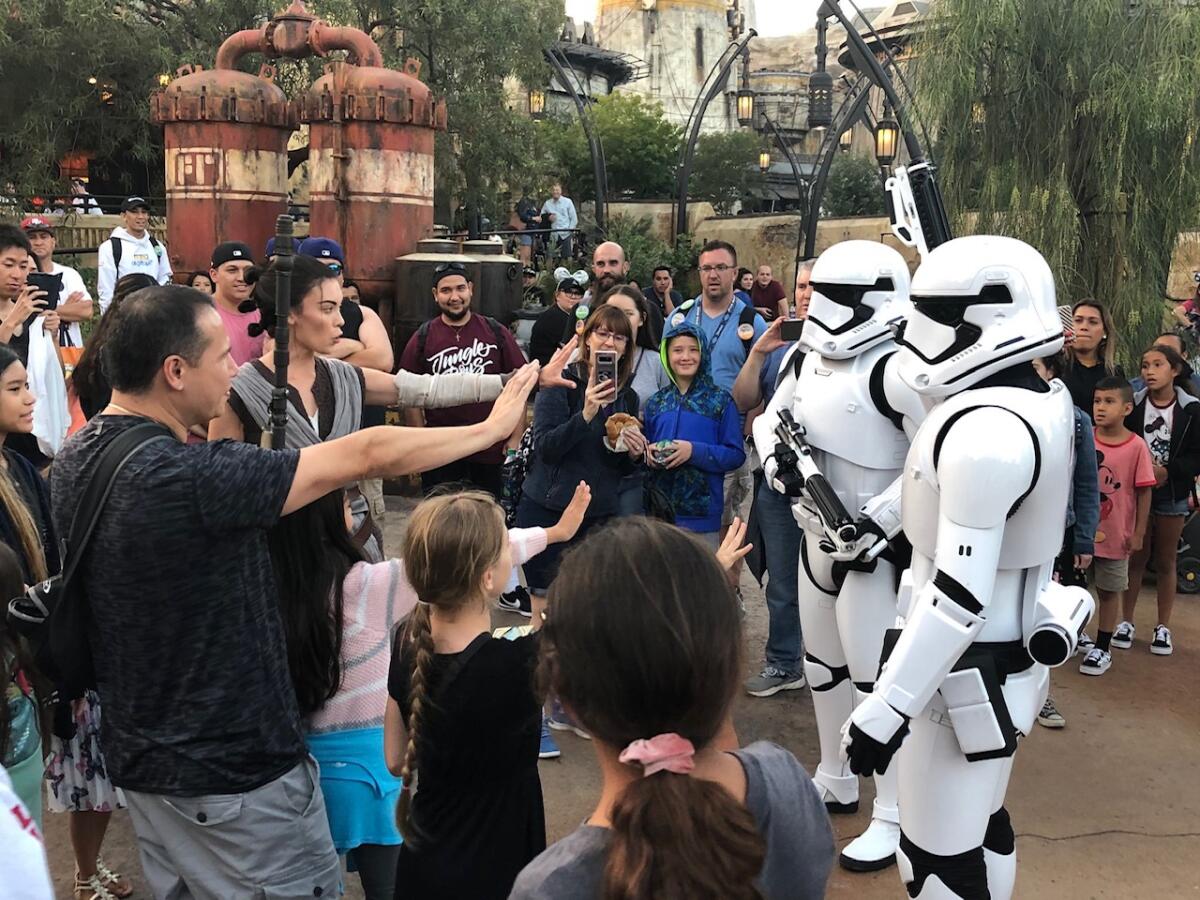
Spotlight on cast
Disney has stated that the majority of its layoffs will affect part-time workers. This puts a spotlight on an unheralded aspect of the theme park design process. One of the most crucial pieces of a park is the undervalued, overlooked and arguably underpaid staff, employees who act as honorary citizens of these fantasy worlds, in addition to serving as pretzel vendors. Without an abundance of them, a billion-dollar land expansion, however artfully crafted and exquisitely designed, can be relegated to feeling like a deserted theater.
Sure, there are the official performers — and I assure you that few things in life are as heartwarming as watching the “Star Wars” character Rey teach a pack of kids how to use a Force stance to propel a pair of Stormtroopers — but as a cast member whose first job at Disneyland was selling churros said, “For some quests, that churro may be the reason they are there.” Thus, you don’t just have to sell the churro, you have to also sell the idea that said churro is pretty special.
Disney announced a new theme based on “The Princess and the Frog” for Splash Mountain, long criticized for its association with the racist film “Song of the South.”
I grew up in Chicago, and my family traveled to Walt Disney World rather than Disneyland. Whenever I think about what hooked me on the parks, it wasn’t the robot pirates or the runaway mining railroad. It was the long-since-shuttered Adventurers Club in a shopping district of the resort now known as Disney Springs.
A 10-year-old’s memories are fuzzy, but in mine, the wait staff that would grab a kid by the hand and show him an assortment of puppetry, comedy and magic, as well as spin exaggerated tales of global adventure, forever cemented a lifelong love of Disney’s theme parks, leading today to a desire to better understand how the places we build can help unlock such deeply personal emotional connections.
When Disneyland inevitably reopens, there will be enough cast members on hand to staff the shops, run the rides and enforce the welcome requirements to wear a mask. But some sense of life will no doubt be lessened. Just before the pandemic took over America, Disneyland launched the exciting Magic Happens parade, a vibrant, sassy and bold work of musical street theater now more or less relegated to a bin labeled, “Do not open until there’s a vaccine.”
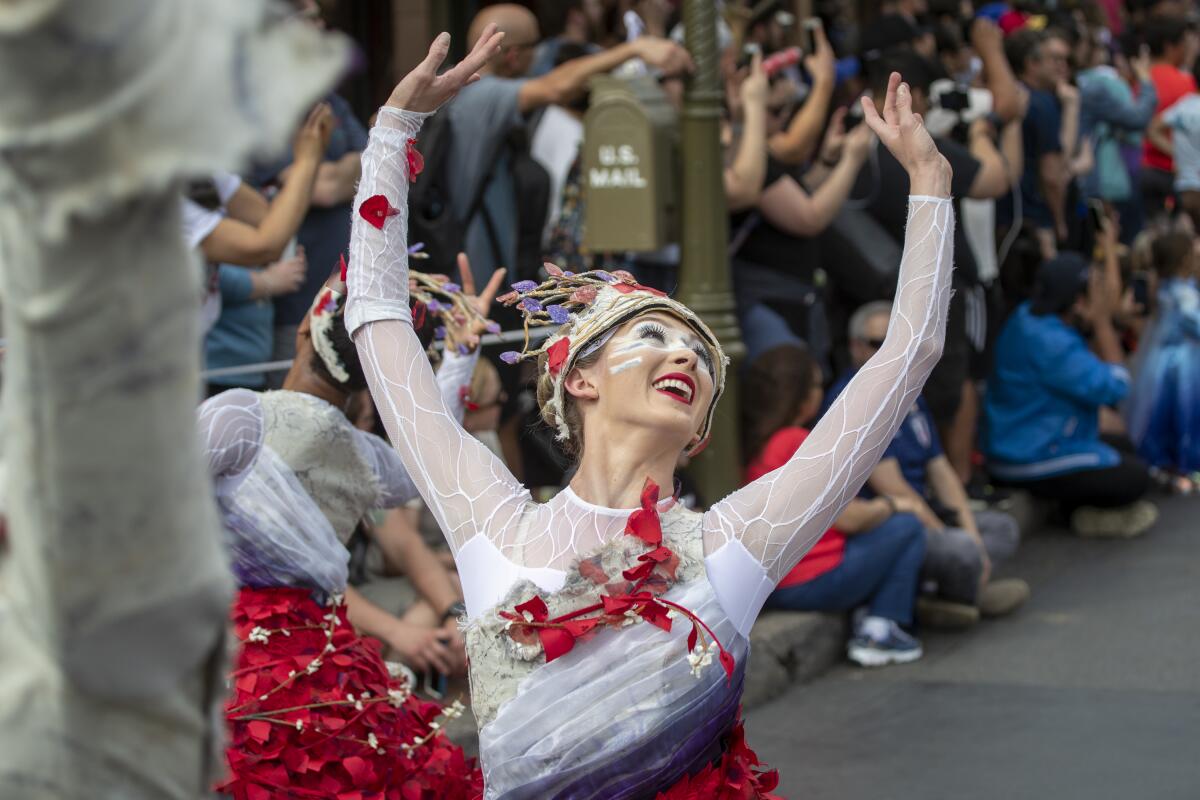
With Broadway shuttered at least until May, live entertainment at our theme parks and beyond will clearly remain in crisis mode for some time. Among Disney’s cuts was a sketch artist who worked on Main Street, a turn-of-the-century vista where candy makers craft treats in windows and an assortment of horse-driven carriages and vintage vehicles shift the focus of the stage to us, the guests, making it clear that we are walking into a story. We can enter a shop anywhere, but at Disneyland, we step into a store where an illustrator works and talks to us about her craft.
We like to imagine that everything will return to “normal” someday, but unknown is how much of 2020 will forever alter what we consider normal. Disneyland’s rides will always impress, but it’s the interactions with, say, an artist in a Main Street shop that sell us on going back. Every Disney cast member said that if they’re laid off, they hope to return eventually, but that happens only if the country gets serious about COVID-19 and there’s a robust middle class to actually spend money on a place like Disneyland.
I’m eager to return someday to Flo’s, that diner nestled next to a fake race track, but even Cars Land recently served to remind me that a theme park is only as exciting as the people who staff it. The land lost a tinge of its celebratory feel a few years back when it pulled the plug on a ridiculously silly dance party that occurred nearly hourly, a small reminder even then that Disneyland’s buildings and rides were primarily set pieces for its cast members to explore.
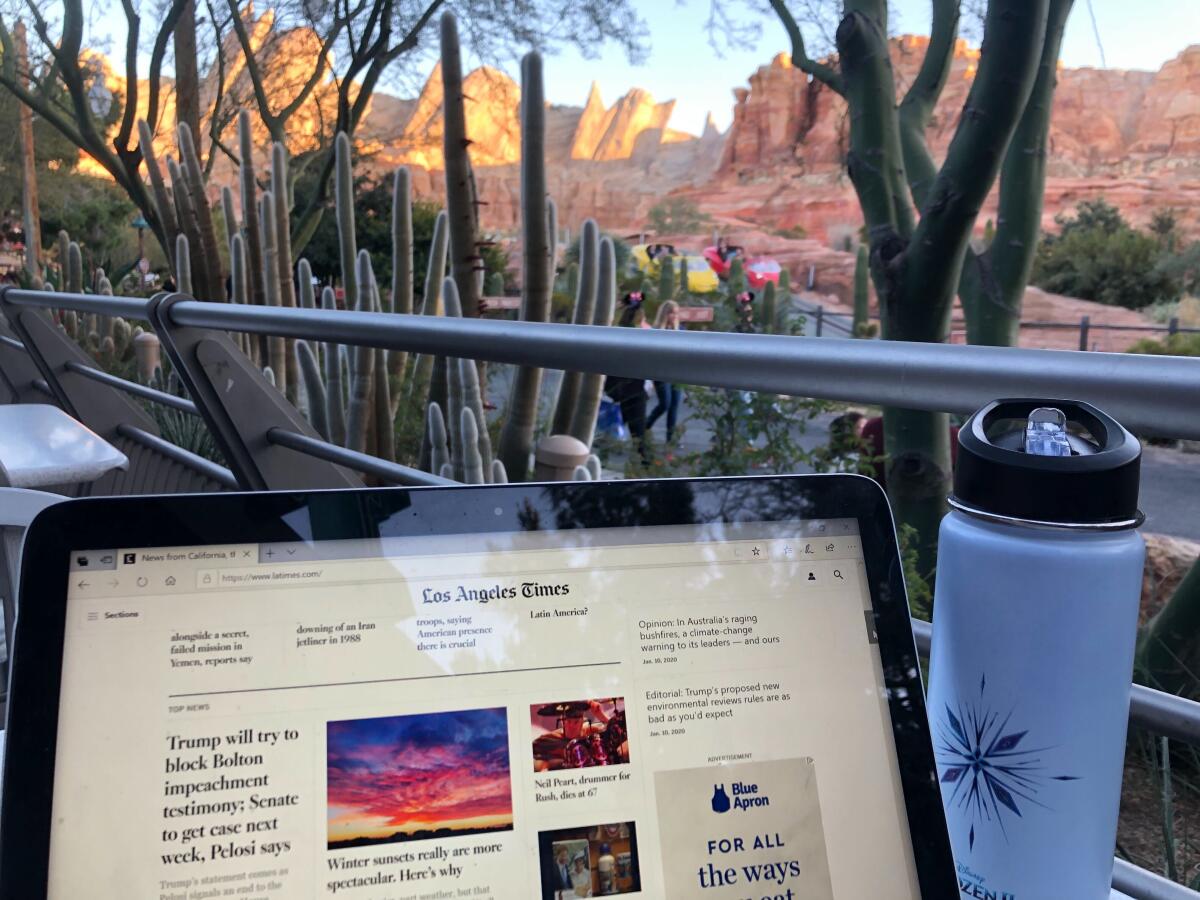
“After working a number of other jobs, this is what I realized about working at Disney,” said that former skipper-turned-Grand Californian front desk clerk. “Going to Disney is like being a kid anticipating Santa Claus. Working for Disney is like being an adult who’s Santa Claus.
“But it’s the same. A magical belief in something that is bigger than any one of us. When all of us work together, it sells that belief.”
And that, right now, sounds like a lesson America would be wise to remember.
More to Read
The biggest entertainment stories
Get our big stories about Hollywood, film, television, music, arts, culture and more right in your inbox as soon as they publish.
You may occasionally receive promotional content from the Los Angeles Times.
